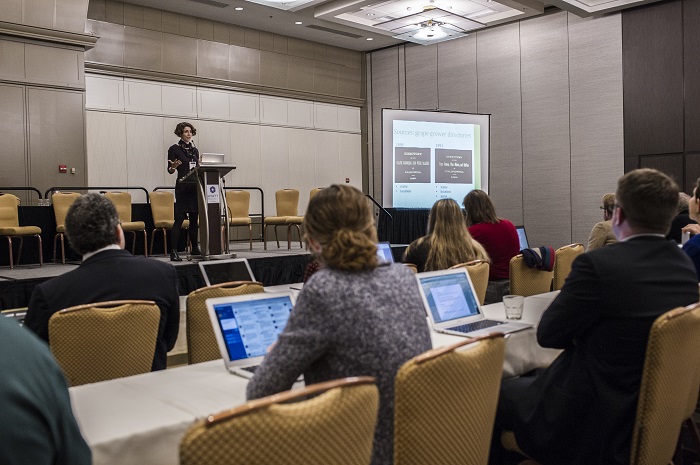Historians are used to delivering their research in the form of thoroughly expounded articles, papers, or books. The 20-minute talk had long been the standard conference format. In recent years, however, enthusiasm for a much more abbreviated form—the lighting round—has grown. In this format, presenters take the stage for 1, 3, perhaps 5 minutes each, to summarize their research or projects. Akin to the elevator pitch, this presentation format challenges scholars to delineate the highlights of their work and explain its importance in a very brief span of time.

A participant presenting at the digital projects lightning round session in Atlanta. Marc Monaghan
Lightning rounds have long been popular at THATCamp and other unconferences, and they offer a variety of benefits. Because each presentation is short, the entire session can accommodate many presenters. So instead of hearing about three, or at the most five, different projects, attendees and presenters might hear about 20 or more in the span of a standard conference session. Whatever the theme of the round, the sheer number of presentations offers the chance for exposure to wide variety. It also gives more scholars the chance to present their work and receive feedback. Long a staple of the digital history and digital humanities community, lightning rounds tend to be less formal and provide emerging scholars with a low-pressure environment in which to share their work.
Since the 2015 meeting in New York, the AHA has been holding the popular Digital Projects Lightning Round. Participants have spoken about digital mapping projects, network visualizations and prosopography, history tour apps, database work, historical gaming, digital editing projects, and more. The research reflected both geographical and temporal diversity, offering attendees a rich buffet of projects using digital methods.
Lightning Rounds at AHA17
This year, we will once again hold the Digital Projects Lightning Round. (We have a full slate of presentations, but we’ll open the floor to more if we have time at the end.) This round invites historians working on digital history projects to share their work in a series of three-minute presentations; we currently have a line-up of 20 participants, and the round will conclude with time for questions. This session is an excellent opportunity for scholars to get feedback on projects at any stage of development, hear about other types of projects and methods, and network with other digital historians.
We are also pleased to announce our first-ever Dissertation Lightning Round, moderated by Jennifer Serventi (National Endowment for the Humanities). The AHA Research Division has organized this session in order to highlight the range of new research by graduate students and to encourage students to practice explaining their work to other historians as well as nonspecialists. The session intersects with the AHA’s Career Diversity for Historians initiative, which emphasizes the value of communicating ideas as a skill that is important for the careers of history PhDs inside and outside the academy. Presentations in this round will be five minutes long, with some presenters organized ahead of the meeting and open slots reserved for students to jump in during the round.
Tips on Crafting a Lightning Round Presentation:
- Consider your project or research; ask yourself the following questions to identify the highlights of your work and use them to craft talking points for your presentation:
- Is your project or research collaborative? If so, acknowledge fellow researchers.
- What major question does your research or project attempt to answer?
- Does it make any interventions in your area of study? (Give minimal background—just enough to situate your current work in the field.)
- What were your research methods?
- What did you learn in the process of creating the project or conducting your research?
- What are your next steps?
- Do not read; lightning presentations should feel conversational rather than formal.
- Rather than getting a lot of details in, focus on presenting the highlights of your work in a compelling way; this will encourage your audience to look up your work later and perhaps ask you questions about it.
- If your project or research lends itself to visuals, consider using a PowerPoint presentation or giving a demo of the project.
- Practice your presentation and time yourself. Using technology can take longer than expected, so budget your time accordingly. Being comfortable giving your presentation will also help avoid nervous hiccups or asides that can put you over time.
- If you do run out of time, have a takeaway/conclusion prepared so you know how to finish quickly and confidently.
- If using slides, include the web address of your project and your Twitter handle (if you have one) on at least the opening and closing slides so your audience knows how to get in touch.
The AHA is committed to expanding opportunities for historians at all stages of their research and careers to share their work and receive feedback from colleagues. We welcome session proposals for AHA18 making use of experimental formats, such as the lighting round, that will enable more historians to participate in the meeting.
Note: Thanks to Patrick Murray-John and Nick Little for contributing tips via Twitter.
This post first appeared on AHA Today.
Tags: AHA Today 2017 Annual Meeting Digital History
Comment
Please read our commenting and letters policy before submitting.






